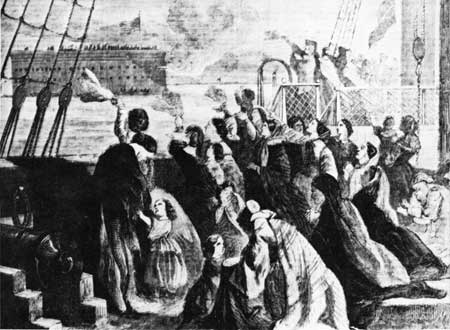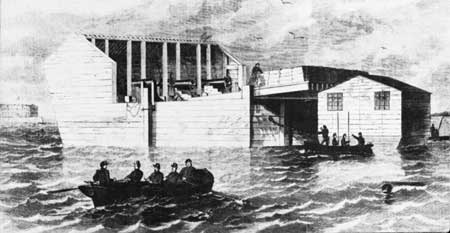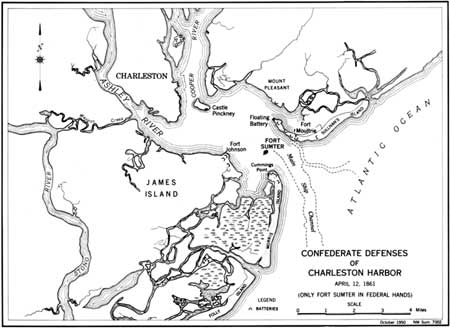|
FORT SUMTER National Monument |
 |

In the face of war preparations, wives and children
leave Fort Sumter, February 3, 1861.
From Frank Leslie's
Illustrated Newspaper, February 23, 1861.
Lincoln Orders a
Relief Expedition to Fort Sumter
On March 4, Abraham Lincoln assumed office as President of the United States. In a firm, but generally conciliatory, inaugural address, he made it clear that national authority must be upheld against the threat of disunion. As to the Federal forts and property in the seceded States he said: "The power confided to me will be used to hold, occupy, and possess the property and places belonging to the Government ..." He did not say "repossess." Furthermore, there needed to be "no bloodshed or violence" as the result of this policy "unless it be forced upon the national authority." The President concluded:
"In your hands, my dissatisfied fellow-countrymen, and not in mine, is the momentous issue of civil war. The Government will not assail you. You can have no conflict without being yourselves the aggressors. You have no oath registered in Heaven to destroy the Government, while I shall have the most solemn one to 'preserve, protect, and defend' it."
The Sumter situation was placed squarely before Lincoln on the day he assumed office. On the morning of Inaugural Day the outgoing Secretary of War received a dispatch from Major Anderson at Fort Sumter indicating that the remainder of the "issue" rations brought over from Fort Moultrie in December would last only a few more weeks. Meanwhile, in the face of local preparations, an estimated force of 20,000 men would now be needed to reenforce and supply Fort Sumter. It was clear that if Anderson's local "fresh food" supply were cut off, he would soon be in a desperate state. At the same time it seemed almost equally clear that a relief expedition would be an impossibility. The entire Army of the United States numbered less than 16,000 men. "Evacuation seems almost inevitable," wrote General Scott; the majority of Lincoln's Cabinet agreed. But Lincoln investigated further. In the meantime, reassured by Secretary of State Seward as well as by others, the South came to believe Fort Sumter would be evacuated.
On April 4, President Lincoln sent word to Major Anderson that an attempt would be made to supply Fort Sumter with provisions "and, in case the effort is resisted . . . to reenforce you." Convinced from "on the spot" reports that such an expedition was feasible, and that there was no Union sentiment in South Carolina to which to appeal, Lincoln had decided upon the nearest thing to preserving the status quo. Merchant steamers under cover of ships of war would carry "subsistence and other supplies" to Anderson; the ships of war (with troop reenforcements) would be used only if a peaceable landing were opposed. Capt. G. V. Fox, long an advocate of a relief expedition, would command. Meanwhile, in accordance with pledge already given, the Governor of South Carolina would be carefully informed in advance.
The announcement of the expedition to supply Fort Sumter was the spark that set off the explosive forces which had been building up since 1850. The Confederate capital at Montgomery was informed. Anderson's "fresh" provision supply had already been cut off on the 7th; now, his mail was seized.

Artist's conception of the Confederate floating
battery. The structure at the right was designed to be a
hospital.
From Frank Leslie's Illustrated Newspaper, March 30,
1861.
Work was pushed on the harbor fortifications. A new battery mounting two "24 pounders" and two "32 pounders" was unmasked on Sullivan's Island; another ironclad battery was put into position at its western tip. Originally designed to be "floating," this battery mounted two heavy "42 pounders" in addition to two "32 pounders." Near Mount Pleasant another (10-inch) mortar battery was installed. At Fort Moultrie, 11 guns now bore on Fort Sumter, including three 8-inch Columbiads. Additional guns were mounted to command the channels and to guard against landings by the fleet. Three thousand more troops were called, to be added to the 3,700 already on the post. The harbor seethed with activity.
"The gage is thrown down," said the Charleston Mercury, "and we accept the challenge. We will meet the invader, and God and Battle must decide the issue between the hirelings of Abolition hate and Northern tyranny, and the people of South Carolina defending their freedom and their homes."
Now, just in time, a small (12-pounder Blakely) rifled gun arrived from England as a gift of a Charlestonian, resident in London. It was mounted at Cummings Point, ominous forerunner of the powerful rifled guns that 2 years later would reduce Fort Sumter to ruin.

Confederate Defenses of Charleston Harbor.
(click on image for an enlargement in a new window)

|
|
Last Modified: Mon, Dec 2 2002 10:00:00 am PDT |


